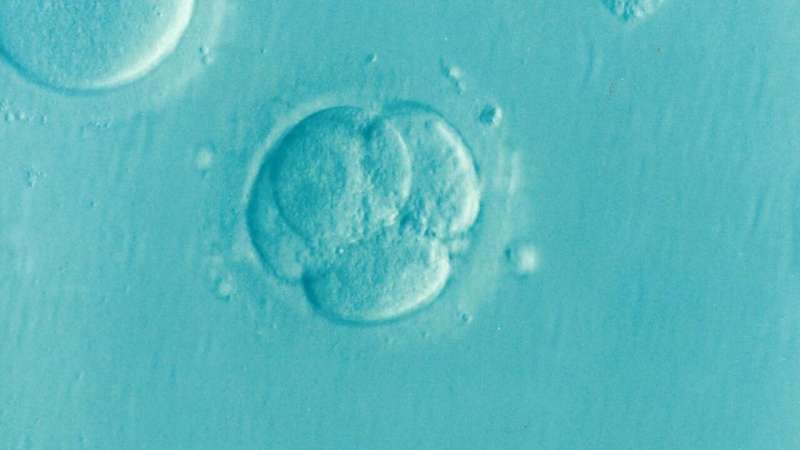
Concerns have been raised over the past few years that pregnancies derived from frozen embryo transfers in IVF might increase the maternal risk of hypertensive disorders, particularly pre-eclampsia, complications which may have severe consequences for the mother and fetus. These concerns have been raised in recent observational studies comparing the outcomes of fresh and frozen transfers, which, by definition, are subject to statistically confounding variables. Sibling comparisons can remove much of this confounding.
Now, a very large study based on real-life registry data and a comparison of maternal complications in sibling pregnancies indicate that pregnancies following frozen embryo transfer (FET) do indeed have a substantially higher risk of hypertensive disorders than naturally conceived pregnancies. This same raised risk (roughly doubled) was also found in a sub-group analysis of sibling births, which was designed to eliminate the effect of any parental factors in the results.
“Our findings are important because the number of FETs is rapidly increasing throughout the world,” said the study’s first author Dr. Sindre H. Petersen from the Norwegian University of Science and Technology, Trondheim, Norway. He will present the study results today the 38th annual meeting of ESHRE in Milan on behalf of the CoNARTaS group (Committee of Nordic Assisted Reproductive Technology and Safety), which monitors the health of mothers and children born after assisted reproduction in the Nordic countries.
According to the latest registry report from ESHRE, the proportion of FET cycles relative to fresh is still on the rise in Europe. In 2017 the proportion was 49%, against 38% in 2014. Similar trends are present in the US and most high-income countries. FETs are increasingly common because of improved cryopreservation methods, facilitation of single embryo transfer, reduction of ovarian hyperstimulation, and the elective freezing of all embryos (“freeze-all” cycles).
The study analyzed more than 4.5 million singleton pregnancies in the registries of three Nordic countries with delivery between 1988 and 2015. Of the conceptions following assisted reproduction, 78,300 were after fresh embryo transfer and 18,037 were after FET. The registry birth references—largely unique to the Nordic countries—also allowed the identification of 33,209 sibling deliveries following either fresh or frozen embryo transfer, and natural conception. “This study was by far the largest sibling analysis to date investigating the association between assisted reproduction treatments and hypertensive disorders in pregnancy,” said Dr. Petersen.
Results of the study showed that the risk of hypertensive disorders in pregnancy were almost twice as high in the pregnancies following FET that in pregnancies following a natural conception (7.4% vs 4.3%). However, the risk of hypertensive disorders in pregnancies following fresh embryo transfer pregnancies was comparable to naturally conceived pregnancies. Adjustments for maternal body mass index, smoking and time between deliveries did not affect the end results, nor did other methods of assisted reproduction (IVF, ICSI, duration of embryo culture or number of embryos transferred).
Hypertensive disorders in pregnancy comprise gestational hypertension and pre-eclampsia, and the more rare but severe conditions of eclampsia and Hemolysis-Elevated-Liver-enzymes-Low-Platelets (HELLP) syndrome.
Dr. Petersen said that the design of this study was not able to assess the relative merits of embryo freezing against the higher risk of hypertensive disorders, but noted that “cryopreservation has facilitated the highly favorable single embryo transfer approach, improving fetal and maternal outcomes by avoiding multiple pregnancies.”
Recent studies have suggested that the risk of hypertensive disorders in FET pregnancies may be associated with therapies to prepare the uterus for embryo implantation. These are usually given in the form of hormone replacement therapy in what has become known as a “programmed” or “artificial” cycle (in which there is no naturally developing corpus luteum to provide hormonal support for the pregnancy). The presence of a corpus luteum, said Dr. Petersen, has become a “hot potato” in recent studies, and “is indeed one potentially important difference between natural conception and fresh embryo transfers on the one hand and FETs on the other.”
He added: “In our analysis all natural conceptions and fresh embryo transfer pregnancies had a corpus luteum, while a subset of the FET pregnancies did not. However, we expect from previous Danish and Swedish publications that in our study, only 15-30% of FET pregnancies were in artificial cycles, which seems unlikely to drive the entirety of the strong association in our results. It thus seems possible that some inherent aspect of the freezing and thawing process, for example epigenetic changes, might be responsible as well.”
Describing his results as “just one piece of a great puzzle,” Dr. Petersen said that it was too early to recommend changes to treatment strategies based solely on this study, and that there are still good reasons why frozen embryo transfers are increasingly used, especially in their facilitation of single embryo transfer.
Source: Read Full Article